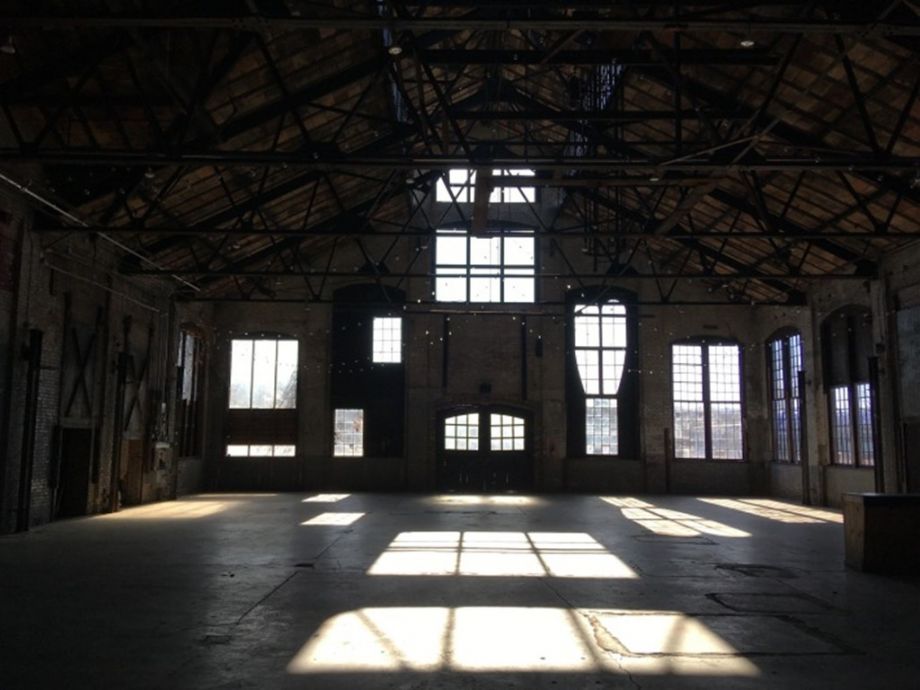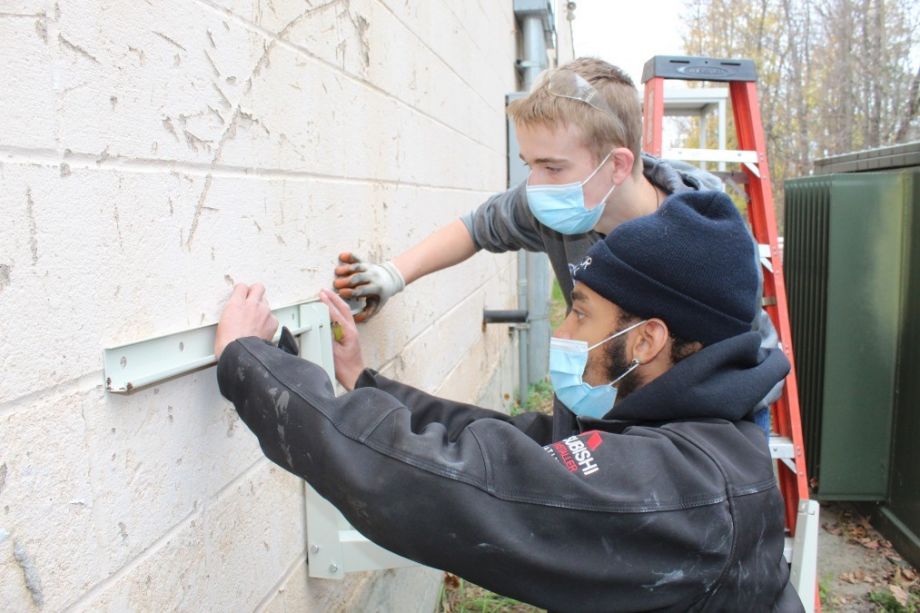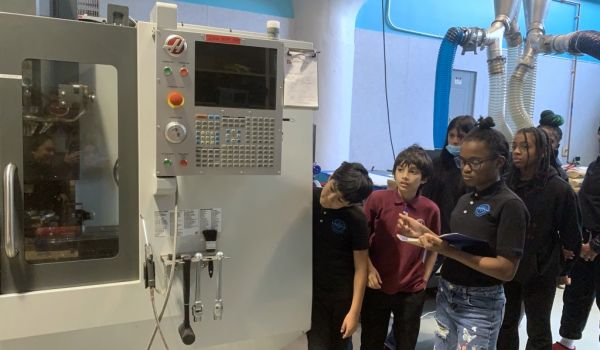In 2019, TIME magazine chose the relentlessly serious 16-year-old Swedish climate activist Greta Thunberg as Person of the Year. “The icon of a generation,” the magazine called Thunberg; the voice of a surging movement of “young progressives already keen to remake the world.”
On the other side of the world, in New Paltz, 16-year-old Jayden Brown just wanted to get through high school.
“My junior year was coming around. My parents talked about pursuing a trade,” he says. Brown’s mother works at a local McDonalds; his father works in a storage facility. A vocational degree from Ulster BOCES seemed like a good idea to the whole family: At least, Brown figured, it would let him spend less time in the classroom than he would at New Paltz High School. “I just wanted to relax and play my sports,” he says.
The pandemic shrank Brown’s world and sharpened his focus. By the end of his junior year, he was working two or three days a week through a “capstone” project—a work experience program that places BOCES students with local employers—and he was thriving. “That taught me a lot of skills — soft skills and in-the-field skills,” he says. “It helped me work with talking to people, being a foreman.”
To remake the world as a more livable place, we might need more environmentalists and climate activists like Thunberg. But we will certainly need a lot of people learning the skills Brown is now mastering as a full-time heat pump installer. How to keep yourself safe on a job site. How to choose the right circuit breaker for a device you’re installing. How to handle different types of refrigerant fluid, which are damaging to the environment if spilled, but are also vital to the heat pump technology that could one day free the world’s buildings from dependence on fossil fuels.
A wave of green jobs is coming to New York. Renewable energy and the rise of building electrification are already driving job growth. As the state ramps up its commitment to clean energy over the next decade, that growth is expected to accelerate.
But in order to seize that opportunity, local institutions — employers, educators, local government, and nonprofits — will need to scale up local workforce training. In the Hudson Valley, local leaders are starting to lay the groundwork for a pipeline that will funnel new workers and people changing careers into the emerging green jobs sector.
Though she’s only been on the job for a few months, Sharon Williams, Ulster County’s new director of the Office of Employment and Training, can already see what’s coming. The state is beginning to put its 2019 climate law, the Climate Leadership and Community Protection Act (CLCPA), into action. Once New York’s draft plan for turning the CLCPA’s goals into policy is complete — a process due to wrap up by the end of the year — a flood of new public and private investments is expected to pour into clean energy and climate action. Jobs will follow the money.
Williams wants to be ready.
“We’re all waiting with bated breath to see what’s going to happen,” she says. “It’s really a timing issue — getting people through the door, getting them trained.”
Between 2015 and 2020, according to figures from NYSERDA, jobs in clean energy grew by 12 percent in New York, even as the pandemic sent statewide employment levels plummeting. But state clean energy experts say there’s a lot more growth to come.
“We see such a huge opportunity for job growth in clean energy,” says Doreen Harris, NYSERDA’s president and CEO. “When we start to look at the clean energy careers that we’re talking about in the future, those types of investments are expected to only grow as we fully decarbonize our buildings.”
In December of 2021, the Just Transition Working Group — a part of New York’s Climate Action Council, the state committee tasked with developing a plan to guide state climate policy — released a study on how working toward the climate goal of decarbonizing New York’s $1.7 trillion-a-year economy will affect jobs in the state. It predicts that by 2030, New York will lose about 22,000 jobs in industries that depend on fossil fuels. Almost half of those will be in gas stations. But for every job displaced by the shift to clean energy, ten more will be created: New York is expected to gain at least 211,000 new jobs related to clean energy, and possibly more if manufacturing gets a boost in the state.
Harris says about 18,000 of those new jobs will come to the Hudson Valley. Most will be in building trades. “We are investing in heating and cooling and automation systems,” she says. “We’re investing in the building shell, as we call it — the envelope itself. Ultimately, what that equates to is a tremendous number of jobs.”
In Ulster BOCES’ HVAC program, about a dozen seniors are currently preparing to graduate into the workforce, some with the credentials Brown earned last spring: OSHA 10 for job safety, EPA universal technician certification, a Green Awareness certificate for knowledge of energy efficiency and clean-energy technology. In January, Brown, who’s now a full-time technician at the New Paltz-based HVAC company Rycor, returned to his alma mater to teach a hands-on class, helping the BOCES students install a heat pump donated by his employer.
“I think me going back and teaching that class shined a little bit of light in some of the kids’ eyes—like, ‘he just graduated, he was here one year ago and look at him now, that’s something that is very possible for me to do,’” Brown says.
Steve Casa, workplace learning coordinator at Ulster BOCES, says that while interest in green careers is picking up, it hasn’t yet translated into a huge increase in the number of students enrolled in clean-energy job training. Right now, the BOCES program, along with other local efforts like Ulster County’s Workforce Development Board and Green Careers Coalition, is focused on building networks to support rapid growth in the job training pipeline.
In Ulster County in particular — a county government looking to be at the forefront of state climate action through its Green New Deal initiative — laying a solid groundwork for green job training is a priority among those involved in workforce issues.
“We all know this is coming. Everybody knows this is coming,” Casa says. “We’re trying to position ourselves so that when the real need is there — and it’s going to be sooner rather than later — we’re ready. This is not going away.”
Old Buildings: A Challenge and an Opportunity
For a lot of people, the phrase “green jobs” conjures images of solar panels and wind turbines. Those jobs are on the rise in New York — and so are efforts to ramp up local manufacturing and supply chains for renewable energy, especially for offshore wind. But the biggest impacts of climate action on the workforce will be felt in the building industry.
A look at the state of New York’s housing reveals the reasons why building trades are expected to drive so much job growth in clean energy. A third of the state’s greenhouse gas emissions come from heating and cooling buildings, mostly from the direct burning of fossil fuels for heat. New York has the oldest housing stock in the nation: As of 2021, the median age of an owner-occupied home in the state was 60, compared to a national median of 39.
The task of making New York’s aging building stock more energy-efficient and preparing it for high-efficiency electric heat is a huge opportunity for the workforce over the next few decades, as well as for high-impact climate action. State investment in that project has barely begun to scrape the surface: In her executive budget proposal for 2023, Governor Kathy Hochul proposed to spend $250 million on electrifying and weatherizing homes, a small step toward the state’s five-year goal of making two million homes electrification-ready, and a tiny fraction of the $10 to $15 billion a year state analysts believe it will take to meet the state’s overall climate goals.
Raising a workforce to solve the energy problems of New York’s oldest buildings won’t be easy, says local building scientist Melinda McKnight, vice president of Energy Conservation Services in Port Ewen. Demand from customers is growing, but it’s hard for companies like hers to find qualified, dedicated workers who want to get into the dirty work of weatherizing old buildings. “It’s a tough nut to crack to find someone who not only wants to work, but is willing to crawl into the nastiest spaces,” she says. “We need an army of them to meet the climate goals of the CLCPA.”
The Hudson Valley has its fair share of old buildings, and each is unique. For some, their beauty and historical importance is as much of a barrier to climate action as their advanced age.

Basilica Hudson recently launched an ambitious net-zero campus renovation project. (Photo by Elvis Perkins)
Take Basilica Hudson: a former railroad foundry with a cavernous 18,000-square-foot unheated industrial space at its heart, given new life in the 21st century as a nonprofit arts and events venue. Under the guidance of Basilica Hudson’s cofounder and director, rock-industry veteran Melissa auf der Mar, the organization recently launched an ambitious net-zero campus renovation project. When it is complete — a process that project manager David Szlaza estimates will take at least $3 million — Basilica Hudson will be a fully weatherized, year-round venue that produces as much energy as it consumes on its five-acre campus, incorporating a solar carport canopy and battery storage to offset the energy use of the building and the air source heat pumps that will heat the vast space.
Basilica Hudson is also seeking to make the project a training ground for green workforce development. “We’ve long thought of our building as a muse,” says Sonia Skindrud, a Basilica Hudson board member who is currently in discussions with NYSERDA, the city of Hudson, and the project’s contractors to create a green jobs training project for five or 10 workers. “Now, we really talk a lot about our building and the campus as a teacher.”
It’s an unusual project, made more challenging by the building’s status as part of local and federal historic preservation districts. But what makes Basilica Hudson’s renovation a challenge might also make it a good training opportunity as a laboratory for practicing retrofits in a way that respects the history and character of a building.
“Those kinds of high energy goals combined with a historic building renovation — when I talk to other designers and project people, it often is met with laughter. It’s hard to do, to thread that needle,” Szlaza says. “And yet there are so many cool historic buildings in our region in the Hudson Valley. Rather than tearing them down — to have a pathway to renovate them in a responsible way for the present and the future is ideal, right?”
Turning Green
For workers like Brown, the clean energy transition might be their first real taste of the working world. Others take a more roundabout path toward a green job.
Before joining the local green workforce, Desireé Lyle had a more office-based career in nonprofit work and investment banking. Lyle bought a wild piece of land in Saugerties in 2017. “I wanted to have a simpler life, closer to the earth,” she says. “I wanted to build a tiny house in the woods.”
What began as a way to earn the hands-on skills she’d need to develop her own property has become a calling. In 2020, Lyle enrolled in the first year of Empower Kingston, a program run by Citizens for Local Power that gives green job-seekers field training. In the first week, McKnight came to give the students a talk about building science. Lyle’s ears perked up. “That really intrigued me — the science along with the building and construction,” she says.
Ultimately, Lyle’s Empower Kingston course led to a stint at SUNY Ulster’s Green Careers Academy, and then to a six-month job training placement with McKnight’s company. She is now a certified building analyst with her own business, Simply Sustainable LLC, where she offers home energy audits, air leakage testing, and a variety of educational and consulting services on building science and energy efficiency. She also serves on Ulster County’s workforce development board, and is working with Citizens for Local Power to expand and deepen the Empower Kingston program that got her started. “Instead of being four weeks, it’ll be an eight-week program and will give people the opportunity to work in different industries,” Lyle says. “People will have an opportunity to work for longer in the fields that they are most interested in.”
To Williams, the Ulster County employment office director, Lyle’s path exemplifies what green workforce training can do for people. “We provided a little bit of support for her employer during her on-the-job training period. And then after she left there, she started her own business. I mean, what could be more successful?” Williams says. “She’s an amazing advocate and spokesperson — trying to encourage more women to be a part of the field, encouraging more people of color to be a part of this field, seeing where it is viable for them.”
As a Black woman in the building trades, Lyle is in a couple of demographics that are deeply underrepresented in the clean energy industry. According to a 2021 NYSERDA report on the clean energy industry, Black workers make up just 8 percent of New York’s clean energy workforce, but 17 percent of the state’s total workforce. Women hold just 25 percent of New York’s clean energy jobs, compared to 49 percent of state jobs overall.
Boosting participation in the green workforce among underrepresented groups is a priority for NYSERDA. The authority offers extra support in their on-the-job training programs for employers to bring on workers in “priority populations,” which also include veterans and workers making the transition from a fossil fuel-dependent industry.
Equally important, Lyle says, is for people who might not have considered a career in the building trades to have more opportunities to gain some familiarity and get a little more comfortable.
“I was extremely intimidated to walk onto a construction site, which is why I never did it until I started this program,” Lyle says. “I think that these kinds of training programs are exactly what’s needed. How else is a person supposed to have an experience on a construction site without that introduction?”
One factor that might help spur wider participation in green jobs training: It’s no longer a second-tier career path. Educators say that the stigma around vocational education, which once discouraged ambitious young people from pursuing the kind of practical job training BOCES and other workforce development programs offer, is fading fast. “We’re seeing a major shift in the attitude around that,” Casa says.
Lyle agrees. “I think a lot of people are frustrated because they’re finding that having a college education doesn’t necessarily pay back,” she says. “In 2022, people are probably more concerned about finding a sustainable career. A lifestyle that provides dignity and security for a worker and their family. You shouldn’t have to go into debt to find that.”
This Is What Green Energy Looks Like
On a bright February morning, it was 8 degrees in Rycor’s New Paltz parking lot. Inside the company headquarters, where a pair of electric heat pumps kept the space at a balmy 71, visiting master electrician Chris Peone was giving a PowerPoint lesson.
“If we take these two little screws off and look under the cover, what do we find here?” Peone said, gesturing at a slide of a water heater.
“Another ground screw,” one employee volunteered.
“Another ground screw! I’m glad you know that,” Peone said.
Most of the people in the room aren’t here on a mission to save the planet, but this is what the climate action revolution looks like: A team of young workers in black company-issue Milwaukee jackets and work boots, getting a lesson on circuit breakers.
In the past year, Rycor has more than tripled in size, growing from about a dozen workers in early 2021 to more than 40 now. Rapid growth means there’s a lot of new ground to cover, and most mornings at the company start off with a little education, says founder Scott Arnold.
“All the teams sit down together before they go out, and they get to talk about what went right yesterday, what went wrong yesterday, how can we learn from that,” Arnold says. “To get someone trained from knowing nothing, it’s somewhere between 30 and 90 days to be a pretty competent member of the team. And within six months to a year, fully competent at everything that we do as a heat pump company.”
As the owner of a local business whose rapid growth is being fueled by the rise of clean energy, Arnold has gotten involved in helping to build the local career education pipeline, working with NYSERDA and programs at Ulster BOCES and SUNY Ulster to help students get real-world training and job placement. Other local employers are also stepping up for green career training: Advanced Radiant in Stone Ridge works with NYSERDA’s training programs, as does Aaspen HVAC in Carmel.
According to Harris, 19 employers in the Mid-Hudson region have helped get more than 100 workers through NYSERDA’s clean energy on-the-job training program, which provides training assistance and partial reimbursement for the wages of new hires.
It’s a drop in the bucket compared to the 18,000 clean energy jobs that are coming to the Hudson Valley over the next decade, and the pipeline for training workers needs to grow. In the near future, Harris says NYSERDA has committed $120 million to expanding its existing workforce development and job training efforts, which are also supporting local programs at places like Ulster BOCES, SUNY Ulster, and the Westchester Community Opportunity Program. Alongside NYSERDA’s quasi-public funding, which mostly comes from ratepayer fees on utility bills, Harris says private businesses are ramping up investments in education to make sure they’ll have the workers they need.
“$120 million gets us a long way with bringing those hundreds of thousands of trained workers forward,” Harris says. “But the thing that makes me the most excited about this is the leverage that you see—the actors that are moving forward, because there’s not only incentives from NYSERDA, but frankly, the opportunity to benefit from this new economy.”
Brown is looking to the future, too—and although he loves his work at Rycor, a job in clean energy might not be forever. He plans to earn a college degree eventually, and possibly go into business or real estate. But for those just a little younger than he is, he recommends going the green job training route.
“Having a trade under your belt is great, because you’ll always have work,” he says. “It’s a great feeling. If I need to be able to fall back on that knowledge, then I can.”
This story was originally published by the River and appears here as part of the SoJo Exchange from the Solutions Journalism Network, a nonprofit organization dedicated to rigorous reporting about responses to social problems.

Lissa Harris is a staff writer at The River and a volunteer firefighter. She was the founding editor of the Watershed Post, a site that covered local news in the rural Catskills from 2010 to 2017.
Follow Lissa .(JavaScript must be enabled to view this email address)
















